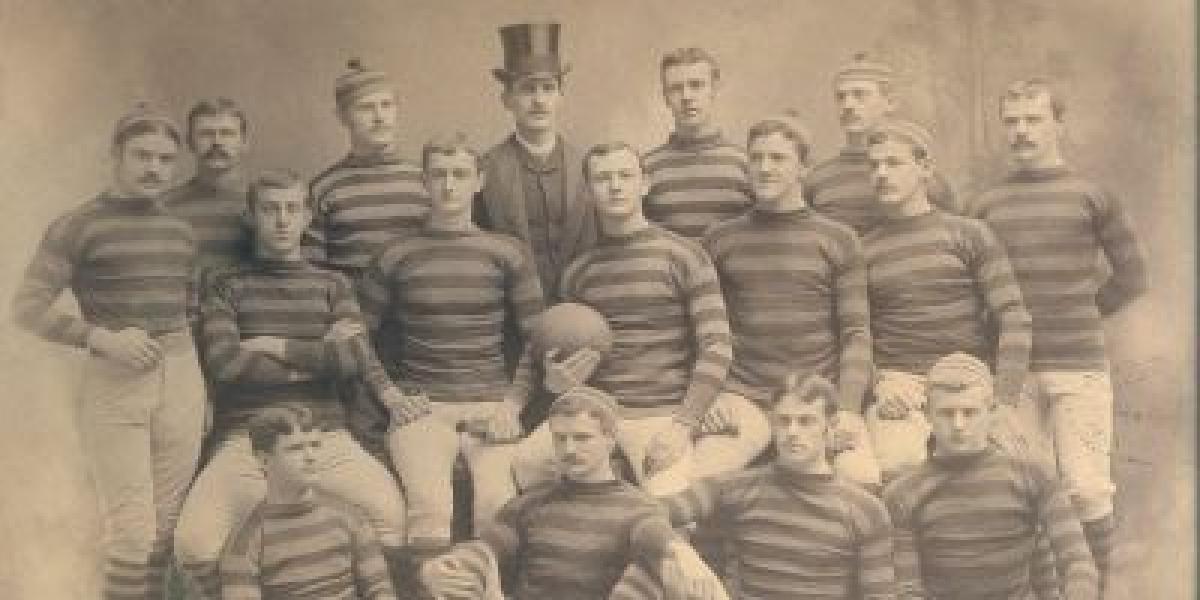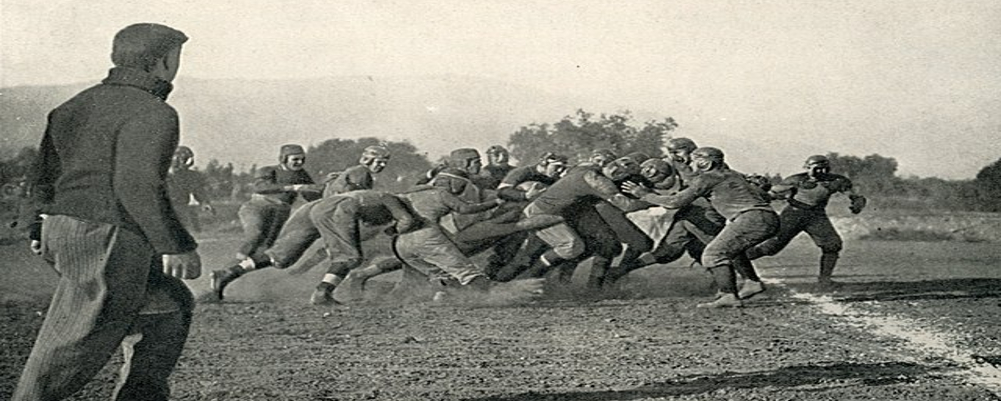Before the modern era of choreographed celebration dances and meticulously planned two-point conversion attempts, scoring in football was a simpler, yet no less dramatic, affair. While the thrill of a touchdown, the tension of a field goal, and the rare excitement of a pick six or scoop score have remained constant throughout the sport's history, the methods for tallying points have evolved significantly. Imagine a time before the ball spike became a post-touchdown staple or when the extra point wasn't always a given. Even the elusive safety, the ultimate defensive TD, has a history. This story explores the fascinating evolution of scoring in football, from its early days to the modern game, examining how each method, from the standard touchdown to the rarely seen special score, has contributed to the sport's rich tapestry.
Original Scoring in Football Methods
We are so used to scoring in football, which is a touchdown equating to six points with the opportunity for another point or two available with a successful PAT. Likewise, a field goal is worth three, and so on. But what if we learn that football has not always had the tally in that way with points?
Timothy Brown of Football Archaeology joins us again this week to educate us on another aspect of football. This week we chat about the evolution of football scoring and the time before the current point-based system. Timothy Brown's FootballArchaeology.com has a daily football factoid that he shares that is really quite interesting in a short read. They preserve football history in a very unique way and we are quite happy that Tim has agreed to join us each week to go over some of his Today's Tidbits. Click that link and you can subscribe for free to receive them yourself each evening.
Of course, this discussion all stems from Tim's original article titled: Football Before Points-Based Scoring.
Transcribed Conversation on Football Points-Based Scoring with Timothy Brown
Hello, my football friends. This is Darin Hayes of PigskinDispatch.com. Welcome once again to The Pig Pen, your portal to positive football history. And we are at our Tuesday event, what everybody's been waiting for: Football Archaeology with author Timothy Brown. Tim Brown, welcome back to The Pig Pen.
Hey, Darin; thank you once again. I look forward to chatting and seeing what we find out today. Yeah, no, Tim, you have some really interesting topics that come up on your tidbits and some of the other works that you put out.
And I know you have a lot of different avenues where you're bringing in information for your research. But one of them that I know you've mentioned in the past, and maybe go into a little bit more detail, is the collection that you have of some college yearbooks. And maybe you can share a little bit about how you get information from those.
Yeah, so I actually only have about I probably have about a dozen college yearbooks that I physically own. But I've got a couple thousand that are, you know, PDFs. And then I subscribe to a thing called eyearbooks.com. So if I'm able to download them, I download them, you know, from university sites, just because then it's just handier, it's easier to search through them.
But you know, basically, what I do is if I'm watching a football game or kind of listening to the news, but not really paying full attention, a lot of times I'm just, you know, scrolling through college yearbooks, looking for images. You know, it could be the artwork in, you know, the athletic or football-related artwork, but mostly, I'm looking for images that just show something about the game at the time that is not, you know, it's no longer part of the game, or it just it illustrates a concept. And other times, it's just, hey, it's just a really cool-looking image, right? I mean, some of the photographs are just great.
And so, you know, what I do is I just have a way of pulling those off; I kind of catalog them with a brief description. And then, you know, sometime down the road, when I'm looking for a topic for a tidbit, or, you know, for an article that I'm writing, you know, I kind of scroll through my items to do searches on them. And, you know, so I've just got handy, you know, I've probably got, I know, I've looked at over, you know, 3100 yearbooks.
So and, I can tell you which issue is for every school, maybe 140 different schools now. So, you know, and then I just, you know, basically, I've got them available in the little library. So anyways, that's, you know, a lot of the way I illustrate stories or generate stories, it's just looking through these old images.
Like, oh, yeah, I haven't talked about this one yet. So let's do a story about it. So a lot of times, the images that you're collecting are, whether it's through PDF or from the yearbooks in your own collection, those are your inspiration for some of your posts and tidbits.
Yeah, you know, because there's the unfortunate thing with the yearbooks, there really isn't a good way to just search through all these yearbooks. So, you know, in some cases, I know, for instance, that I'm, you know, I'm writing about a particular topic; I came across an article while I was doing some other research. And then I'll go to that yearbook, you know, that team's yearbooks, to see if there are images that relate to the article I'm writing.
But, you know, certainly a lot of times, I'm just going in, you know, I found, you know, in all in, in all the yearbooks that I've got, I found two images of the punt out process, you know, so, you know, basically a part of the game that disappeared in 1922. And, but I found two punt outs, you know, and it's just, it was great, just because, you know, if you didn't know what a punt out was, you wouldn't even know what the heck that image was, or what it was representing. But I, you know, I spotted these two, I think one in Texas, and one, one was a Chicago game, maybe might have been an Illinois yearbook.
But anyway, you know, it's just kind of cool stuff, just finding these things that, you know, at least it shows, hey, this really did exist. Right. It wasn't just a story.
That's interesting. And you bring something to light that many of us don't know. I mean, even somebody like myself, I learned something new almost every day.
And I'm, I'm quite a bit in the books and newspapers and everything else in football history, but I learned something from your tidbits each and every day. So I think listeners, you can too, we'll give you some information near the end of this program. So, and it's in the show notes as well.
So you can get connected with Tim and the great tidbits he has each and every day. But today's topic, we're talking about old football, but we're talking about even a little older than your, uh, the pun outs of, uh, you know, 1922 when they ended, uh, going to football before points-based scoring. And, uh, I think that's an interesting topic you had back on September 9th. It is one of your tidbits, and I hope that you could chat about that a little bit tonight.
Yeah. So, you know, uh, you know, football, as we, as everybody knows, is derived from rugby. And when the, uh, intercollegiate football association met in, uh, 1876, they basically adopted the rugby rule book with three or four exceptions.
You know, they did change a couple of things. Um, and one of the things was just kind of renaming, you know, they named whatever rugby call it, they called it touchdown instead. Um, but so the scoring was just, it's not what we think of as a normal scoring system today.
So I'm going to read this just because it's kind of bizarre, but, um, rule number seven from that rule book defined, you know, the scoring process in one; it says a match shall be decided by the majority of touchdowns. A goal, a goal shall be equal to four touchdowns, but in case of a tie, a goal kick from a touchdown shall take precedence over four touchdowns. I mean, that just sounds like total gobbledygook, but you know, back then, the goal or the purpose of football, what you were trying to do was to kick the ball through the uprights, and a touchdown was really just a means to an end.
It wasn't the end. It's, you know, for the most part, it wasn't the end itself. So you wanted to kick; you wanted to score a touchdown because then you got a free kick at the goal.
Um, and you know, you also, um, and so, you know, now we all know that the touchdown is what really counts, you know, at six points in the, the kick after the touchdown is only worth one. But back then, the game was very much a kicking game. Um, and so, you know, the value came in, in, uh, kicking goals.
And so, you know, it was basically, um, you know, it was this equivalency-based system. It wasn't a straight-point process. Like we, I think virtually every sport used today is just this kind of gobbledygook: a goal shall be equal to four touchdowns.
Um, so, you know, so basically, you'd have four touchdowns to add the same value as just one goal kicked through the, um, you know, through the uprights. Uh, however, if you, a goal kicked from touchdown, meaning a goal kicked after the touchdown, if two teams ended up tied, one had four touchdowns, the other had a goal kicked after the touchdown, then that the latter team would win. That's what the last part of that rule meant.
Okay. So the kick, the kick, uh, took the kick being good was more important than the four touchdowns, which equal the same amount of points. Yes, because it was; it came the kick, and the kick came after a touchdown.
Okay. Gotcha. You know, as opposed to a goal from the field, which would have just equaled the goal.
Now I know you have this, uh, in your book, uh, how football became a football, but I'm not recollecting the year right off hand. When did that sort of change from that, that, goal, uh, scored to more of a point-based? Yeah.
So 1883. So still, you know, very early on in the game. And once that occurred, then, um, a goal from the field, what we call field goal.
So as a scrimmage kicked goal could, could have been dropped. Well, at that point it would have all been dropped kicks, but that was worth five points. The goal from touchdown or try after touchdown was worth four points and a touchdown was worth two.
So, in effect, the field goals were five. Um, and then the combination of a touchdown and the kick afterward was six points, right? So, you know, it kind of was making a touchdown worth one point. Right.
Uh, and, and then, you know, safety was one point that year. Um, and then, you know, things, they kept tweaking it as, basically, people became more interested in moving the ball down the field and scoring touchdowns as opposed to kicking goals. Then they kept ratcheting up, um, the value of the touchdown, um, relative to the field goal.
And part of that, too, was just the, you know, they just, they felt, you know, that football was a team game, and they didn't want so much of the point value resting on the ability of a kicker. They wanted, you know, the ability of all 11 to show through. And so the, you know, so they were, they kept adjusting the, the point values until, you know, basically 1912 is when, when we got to our current scoring system, not including two-point conversions and, and, uh, you know, some of the defensive, uh, you know, the one point safety and defensive scores after, you know, extra points, those kinds of things.
Well, we're certainly glad that they did, uh, change it to the way it is now with a touchdown being more, uh, important than, than the field goal and the extra point, because it really changed the landscape of the game and made it a more exciting game and the great game it is today. So, yeah. And it's, you know, it's always, uh, I think especially Europeans make fun of us for having a game called football, where the foot really isn't as big a part of the game as it used to be, but it once was, you know, that that's, that's for sure.
And we just take it for granted. We don't even think about the foot and football being related to the foot. Really.
We just, it's just football. Yeah. So yeah.
Yeah. Very interesting. Tim, why don't you share now? We promised earlier that you would share where, uh, people could get their own subscription or get their own daily dose of your tidbits and, uh, give them the information, please.
Yeah. So, uh, I published a tidbit every day, uh, on, uh, football, archaeology.com, a couple of times a month. I'll publish some other long-form articles.
And then I also published the links to, you know, your, um, your podcast, uh, on the site. So it's football archaeology.com. You can also find me on Twitter under the football archaeology name. And if you were intrigued enough by our conversation about punt outs, there is a story about punt outs that I wrote, I don't know, two years ago, something like that.
So it explains that whole process. So, um, on the, on the front page, there's one of those little magnifying glass search functions. And so you just type in punt and it'll be, you know, it'll pop up without, without an issue.
Okay. Tim Brown, footballarchaeology.com. We thank you once again for sharing your knowledge, your wisdom, and your daily tidbits. And, uh, we'll hopefully be talking to you again next week.
Okay. Very good. Thanks again.
Transcribed by TurboScribe.ai.




